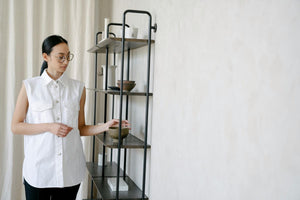How to Use Staging to Improve the Flow of Small or Awkward Spaces

How to Use Staging to Improve the Flow of Small or Awkward Spaces - Making the most of limited space is crucial in any home. It not only optimizes the area but also enhances its flow. This process involves strategically arranging furniture and decor to make any room feel larger and more inviting. Doing this effectively can transform a cramped space into a functional and attractive setting. The following strategies are easy to apply, from selecting the right props to understanding spatial dynamics. Staging to improve the flow will show you how thoughtful design choices can have a big impact, whether discussing a tiny house near Ontario, Canada, or a small Chicago flat.
Understanding the Basics of Staging Small Spaces
Staging is essential for utilizing every square inch of your home effectively. It makes rooms appear larger and more welcoming by arranging elements optimally. Importantly, start by decluttering and removing unnecessary items to free up space. Next, focus on lighting. Opt for light hues on walls and furnishings to reflect more light and give the illusion of space. Combine these with strategic lighting—think wall-mounted fixtures or slim floor lamps to avoid taking up valuable floor space.
Understanding how to effectively place furniture and decor is key. The goal is to create a path for the eye and feet, guiding them through the space smoothly. Use fewer, more functional pieces to maintain an uncluttered look. Sometimes, despite your best efforts, a home remains on the market longer than expected. This could be because potential buyers can't see its full potential if the space feels cramped or poorly presented. Recognizing why your home isn't selling may prompt more targeted staging strategies, showcasing your home's functionality and attractiveness to entice buyers.
Effective Use of Color and Light to Enhance Spatial Flow
Colors and lighting are powerful tools that can transform small or awkward spaces, making them appear larger and more inviting. First of all, select light colors for walls and large pieces of furniture. Soft shades help reflect light, making spaces feel airier and more open. Avoid dark colors that can make a room feel smaller and more confined. Second, good lighting is essential. Use a mix of overhead lighting, floor lamps, and table lamps to create a balanced, functional lighting scheme. Place lamps in dark corners to make the room feel larger.
Mirrors can also amplify natural and artificial light and add depth to a room. Position mirrors opposite windows to reflect outdoor light or place them near light sources to spread light around a room effectively. Ensure windows are not obstructed by heavy curtains or bulky furniture. Use sheer window treatments to maximize daylight. This not only saves on energy but also opens up the room visually. The right use of color and light can make small areas feel more spacious and more appealing to everyone.

Maximizing Functionality Through Strategic Furniture Placement
Effective furniture arrangement is crucial in small spaces to enhance both aesthetics and functionality. But you have to know how to choose and position items to utilize space best and improve flow. For starters, opt for furniture that fits the scale of the room. Large, bulky items can overwhelm small spaces, so choose pieces that are proportionate. Multi-functional furniture, like ottomans with storage or sofa beds, can also be excellent choices.
Then, position them to create clear pathways. This will make the room easier to navigate and give it a more organized look. Arrange seating to encourage conversation and make the room feel welcoming. In addition, the placement of larger pieces can help direct the flow within a room. For example, a well-placed sofa can act as a subtle divider between living and dining areas in an open-plan space. However, before rearranging heavy furniture for staging, it’s wise to plan thoroughly to avoid unnecessary lifting. If you’re “up north”, companies like Centennial Moving Canada are experienced in handling heavy items, which can be essential when preparing a space for staging. Proper planning ensures that each piece is moved safely and placed correctly, enhancing the space’s functionality and visual appeal. Not to mention, you can preserve your health in the process.
Accessorizing to Guide the Eye
Accessorizing can direct attention and create focal points in small spaces. For starters, use rugs to define different areas within a space, such as a seating or dining area. A well-placed rug can anchor furniture and create a sense of organization, guiding the eye smoothly from one section to another. Next, select pieces of art that complement the size of the wall and the overall decor. Positioning artwork at eye level can attract attention and make a room feel more dynamic. Consider using lighter frames or canvas prints to keep walls from feeling cluttered.
If your space has unique architectural details like exposed beams or brick walls, use decor to highlight these features. Small spotlights or directional lamps can emphasize texture and shadow beautifully., Last but not least, remember that less is more. Keep small items minimal and choose a few key pieces that add character without overwhelming the area. Through these simple yet effective strategies, accessories can significantly enhance the spatial flow, making even small or awkward areas feel structured and appealing.

Practical Tips for Staging to Improve the Flow in Small or Awkward Spaces
Successfully staging to improve the flow in small or awkward spaces involves unique strategies to optimize and improve their flow. And there are distinct approaches you can apply to transform these challenging areas. For starters, use vertical dimensions to your advantage. Install shelves up high and hang curtains closer to the ceiling . This will make the ceilings appear higher and the room more spacious. Next, choose slim-lined furniture with exposed legs to increase the sense of floor space visible. Pieces like glass coffee tables or metal frame chairs can help reduce visual clutter.
In addition, instead of overloading shelves, select a few standout items that add character without crowding. A single large painting can be more effective than a group of small frames. Implementing these specific tips can significantly alter space perception, enhancing functionality and aesthetic flow in smaller or awkwardly shaped areas.

Final Thoughts
Effective staging can transform how a space is perceived and experienced. Remember, the right arrangement of furniture, choice of color, and strategic accessorizing can make a significant difference. Together, these elements foster an inviting atmosphere that potential buyers or guests can envision themselves enjoying. By applying these principles, staging to improve the flow becomes more than just a concept. It's also a practical approach to maximizing your living space, regardless if we’re discussing a US or Canadian home.
- Home Staging Warehouse






